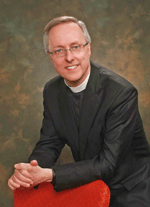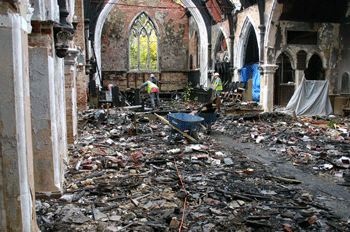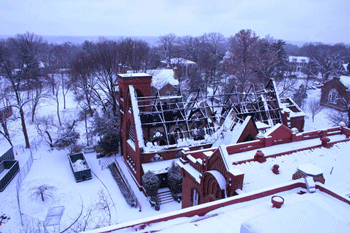On October 22, 2010, Virginia Theological Seminary (VTS) witnessed a devastating fire that gutted its 1881 chapel, which included a treasured stained-glass window by Tiffany. Less than four years later, VTS has recovered $8.6 million to rebuild. The ruins of the chapel have become a garden for contemplation. And a campaign has been launched to build a new chapel, designed by renowned architect Robert A. M. Stern. Would your institution fare as well? Is your insurance adequate? Do you have current appraisals on all historic structures, art, and archival materials?
Moment of crisis
 |
| Ian Markham |
“The first 48 hours are very stressful,” says Ian Markham, dean and president at Virginia Seminary. “Public adjusters started calling while the fire was still burning.” The first decision that Markham had to make was whether to use one of these companies, which negotiate with insurers. As go-betweens, public adjusters traditionally take 10 percent or more of the recovered funds, and “they are loathed by the insurance companies,” says Markham. “But a lot of churches and nonprofits use them. People need an advocate to do the leg work, talk the insurance lingo, and negotiate a fair settlement.”
Markham chose instead to contact the seminary’s insurance company to discuss options. Their response: You can always bring a negotiator in later. Why don’t you talk to us and not start with an adversarial situation? With that understanding, Markham decided to hire an independent consultant to represent the seminary in negotiations. An architect from Hartman & Cox was brought on board to work with the estimator, billing at an hourly rate rather than taking a cut of the reimbursement. Her expertise in church construction — and her knowledge of building costs — allowed her to advocate strongly for the seminary’s interests. “I wanted a representative at the table,” says Markham. “And I wanted her in the same room with the estimator, working out the methodology and doing everything together. The insurance company agreed to this, because they were nervous I’d bring in a public adjuster.”
Surveying the situation
 The Bureau of Alcohol, Tobacco, Firearms, and Explosives ruled that there was no negligence. The fire was caused by charcoal briquettes that hadn’t been fully extinguished, even though the students using them for incense in the chapel had followed all of the proper procedures.
The Bureau of Alcohol, Tobacco, Firearms, and Explosives ruled that there was no negligence. The fire was caused by charcoal briquettes that hadn’t been fully extinguished, even though the students using them for incense in the chapel had followed all of the proper procedures.
The next step was to decide whether the building was a total loss. It was up to the insurance company to determine whether the seminary would repair or rebuild. “It was pretty clear that it was a total loss,” Markham says. “To rebuild in the same location, we would have to bring it up to code. It was already in violation, because it was too close to other buildings. So we were looking at building a new chapel.”
New construction typically takes years, so the seminary needed a place to worship during the interim. The first proposal was to continue to use the seminary’s Scott Lounge, the campus “living room” (where the community was worshiping in the immediate aftermath of the fire), adding chapel chairs and buying new hymnals. But that would mean giving up its main use as a daily dining space, so seminary leaders considered a tent instead. In the end, however, they decided to retrofit the school’s auditorium. The 400-seat space wasn’t functioning well, giving the appearance that events weren’t well attended even when 150 people were present. To improve and update it, seats were removed, a new floor and sound system installed, and a new altar consecrated. “The insurance company had an obligation to help us function,” Markham adds. “And they agreed to the $600,000 to renovate an alternative worship space.”
A good negotiating position
 Virginia Theological Seminary had outstanding insurance coverage. The chief financial officer had worked with the same broker for years, reviewing its policy annually. Every building was valued, plus there was a total cover policy. Combined, the seminary had a ceiling of $58 million. “If the whole campus went up in flames, we would be underinsured,” Markham says, “but we weren’t looking at a maximum payment. The first estimate was $3 million. It was a matter of us going through with care and making our case for as much as we possibly could, for each item.”
Virginia Theological Seminary had outstanding insurance coverage. The chief financial officer had worked with the same broker for years, reviewing its policy annually. Every building was valued, plus there was a total cover policy. Combined, the seminary had a ceiling of $58 million. “If the whole campus went up in flames, we would be underinsured,” Markham says, “but we weren’t looking at a maximum payment. The first estimate was $3 million. It was a matter of us going through with care and making our case for as much as we possibly could, for each item.”
Another asset the seminary had was extensive documentation. The seminary maintains a list of items of value on campus, with the original appraisal from the date it was donated or acquired plus subsequent appraisals. “We don’t do appraisals annually,” Markham clarifies. “But everything is reappraised regularly.” Thanks to this diligence, there was a comprehensive list of items contained in the chapel, including photographs of many items. Some of the contents had been individually appraised, including the Tiffany window and a Steinway piano. These put the seminary in a good negotiating position.
Making major decisions
Together, the seminary representative and the estimator from the insurance company went through everything, estimating the quantity of wood and brick needed, the cost of salvage and storage, and the need for new windows, pews, and crosses. In the end, they compiled a list of 7,000 items, along with quantities or estimates for each item, and documentary evidence of how each figure was calculated.
A critical piece was determining which vendors to call on for estimates. The seminary’s representative was able to advocate for consultants she knew to deliver high-quality work, but there were some points of contention. For example, the company that had built the organ was no longer in business, and there were disagreements about which new company to select. “There were some points where they disagreed with us.” Markham says about the negotiation with the insurer. “That was when I came back into play. We’d been good customers for 35 years.” In most cases, the seminary and insurance company agreed to split the difference.
In the end, VTS received an $8.6 million payout for the chapel, plus $600,000 for the interim worship space. “If we had gone with a professional negotiator, they would have taken a million of that,” says Markham. “Would they have negotiated for more than a million more? I don’t think so, because I’m so sure of our methodology. In our first meeting, the insurance company predicted it would be a $4 to $5 million, and we clearly did better than that.” Markham notes that the seminary’s insurance premiums did rise the year after the claim.
Lessons learned
As Markham reflects back on the insurance negotiations after the fire, he remembers them as very stressful. “I have a Ph.D. in Christian ethics, and I’m a priest. I have not had a lot of training in this area,” he says. He identifies three decisions that made a difference in the outcome:
-
The seminary’s insurance policy was comprehensive and iron-clad. “There was no way they could argue about the coverage.”
-
The seminary didn’t use a professional negotiator, saving almost $1 million in fees, but the threat of one sometimes furthered negotiations.
-
The seminary used a consultant, whose fees came to $60,000, to work with the insurance company. “Hartman & Cox did a stellar job,” Markham says. “They were excellent. I was pleased with their thoroughness and care.”
Markham concludes with the advice to be very careful about insurance. “We never put insurance premiums as an option for balancing the budget,” he stated. “In this litigious and fragile world, it’s just not worth it.”